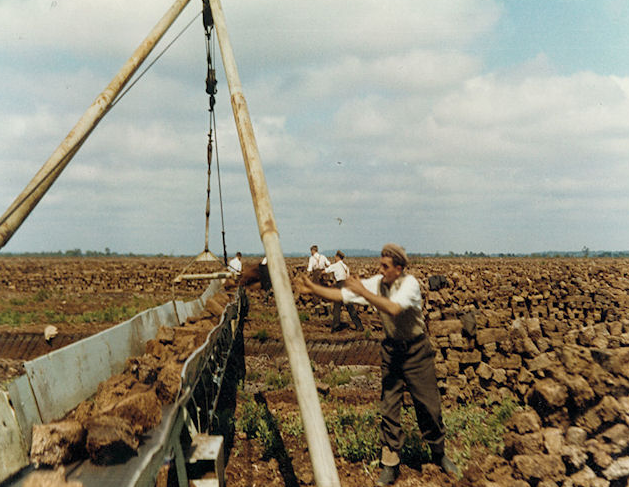Modern energy supply began as a private or local service of gas and electricity, largely based on coal in the early 20th Century. This grew to become national state-owned utilities, which was later unbundled to facilitate competition in generation and customer choice of supplier. The pattern of energy demand has shifted over the years reflecting economic growth throughout history as well as changing relative costs of different fuels, the perceived security of continued supplies and more recently, environmental considerations.
Pre-1800
- 1600 By the end of the 1500s turf was the main fuel in Ireland.

1820
- 1824 By this time there were three gasworks in Dublin; one operating from coal, one from fish-oil and another from turf.
- 1825 The first industrial scale harvesting of hand-won turf at Mona bog along the Shannon began.
1840
- 1845 During the famine years the one of the only forms of heat for cooking and warmth was a peat fire. Where local pits existed, coal also protected the population from the worst ravages of the famine providing employment and fuel.
1850
- 1850 Colonel Kitchener, experimenting with the production of peat charcoal to manufacture gunpowder, discovered how to produce peat briquettes which have a higher heat output and longer burning time.
1900
- 1901 With the growing interest in electricity a private act of Parliament was passed in 1901 authorising the development of bogs in Leinster for electric power.
1910
- 1911 Peat is used to generate electricity in industry e.g. Hamilton Robbs linen factory or the Marconi wireless station.

1920
- 1921 A Commission of Enquiry into the Resources and Industries of Ireland estimated that Ireland used an estimated 4.7 million tonnes of coal and 6 million tonnes of peat.
- 1925 By this time hydro, coal, peat, gas and wind power were all being utilised in one form or another to generate electricity.
- 1927 The ESB (Electricity Supply Board) is established to provide a safe, reliable and economic supply of electricity to the community under the Electricity Supply Bill.
1940
- 1941 Lullymore factory opened to produce briquettes but due to their higher calorific value were allocated to priority industries such as bakeries, Jamesons and Powers distilleries and the railway system.
- 1946 Bord na Mona are established as a peat development and supply utility.
1950
- 1950 First peat-fired generation station in Portarlington opens. Between 1950 and late 1960s, ESB installs over 400 MW of peat power plants.
- 1956 Electricity rationing may have been avoided after the Suez crisis in part due to peat fired power stations and their ability to operate with less expensive fuels than oil.
- 1956 As more peat fired stations came on stream supporting infrastructure was developed such as the first railway bridge to be built across the Shannon for 100 years.

1960
- 1960 Seven exceptional years of low peat yields during a decade of stable economic growth during which demand for electricity grew steadily.
1970
- 1977 Government grant scheme for installation of domestic solid fuel central heating.
1980
- 1980 Financial crisis, temporary high oil prices creating an artificial market, price controls, the ageing of ESB peat fired power stations and the introduction of the private bog scheme.
1990
- 1995 Total peat production peaked at 8 million tonnes.
2010
- 2012 High gas prices and low coal and ETS prices resulted in more coal and peat being used for electricity generation.